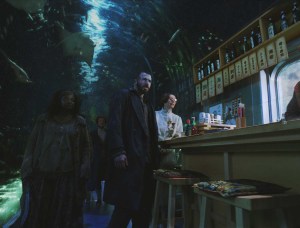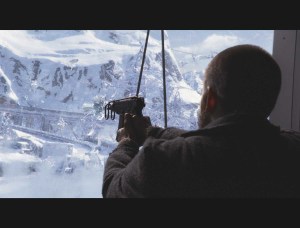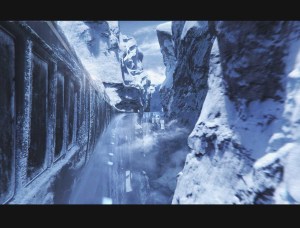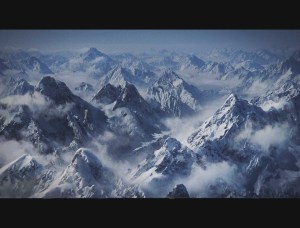
Like the titular train from the 40-year-old French graphic novel on which it’s based, Korean director Bong Joon-ho’s Snowpiercer zipped across the globe and arrived in American theaters this past summer. The film offered a dystopian sci-fi spectacle unique both for both studio-scale visuals in an independent release, and the sharp social critique set in its near-future of careening climate change.
Visual effects designer Eric Durst, oversaw a global network of postproduction facilities in making the film, spanning nearly as much of the globe as the rail line in the story.
Durst started out by addressing his particular credit, which is neither VFX supervisor, nor producer: “In terms of title,” he said, “it’s something everyone in the VFX business is trying to wrap their heads around.”
“You could make the case you’re the visual effects director,” he said, since he oversees as many departments as the director does, but he notes the DGA won’t allow that.
Given that the “supervisor credit is given to five or six people” on a typical production – one for each of the main post houses – the question becomes “how to say you’re overseeing,” and coordinating, all that digital work? “You’re doing the administrating of effects – and who does what,” taking in both technical and financial considerations. “A lot of different roles jumbled up into one. I had the role of visual effects producer as well.”
 For new titles we also have a “different scale of movies” now. At 850 shots, Snowpiercer is now considered a “medium-size show,” and yet digital work touched “every single shot – every single department.”
For new titles we also have a “different scale of movies” now. At 850 shots, Snowpiercer is now considered a “medium-size show,” and yet digital work touched “every single shot – every single department.”
Director Bong’s vision for that show (in Korea, Durst notes, you address people not by “Mr.” or “Ms.,” but by what they do), started to come to life in Prague’s Barrandov Studio, where a series of sets on gimbals created the title train’s rollicking movement. Moving from the soundstage, Durst ended up with four main post houses, including Germany’s Scanline, well known in the biz for its work on surfaces, “chosen to do snow and environmental work,” which in Snowpiercer’s world also includes lots of avalanches.
Other set pieces included an on-board aquarium, along with exteriors of the train, and the ruined cities it passes. Durst asked his colleague Dan Glass – currently wrapping up his own supervisor work on Jupiter Ascending – for suggestions, and wound up bringing Method Studios on board, with Mark Breakspear supervising out of Vancouver.
He also worked with Sean Lee, a VFX producer with 4th Creative Party, a Seoul-based house that Joon-ho had worked with before.
 But Durst found that it was helpful to have post houses physically close at hand as well. Viktor Muller supervised for Czech- based UPP, and “it was great to have a house in Prague. We needed extra support, sometimes on set.”
But Durst found that it was helpful to have post houses physically close at hand as well. Viktor Muller supervised for Czech- based UPP, and “it was great to have a house in Prague. We needed extra support, sometimes on set.”
Dailies were sent to Barrandov’s lab, “then we’d call for VFX shots to be scanned.” UPP would scan the film in 4k, making both 4 and 2K shots available,” both archiving shots and making them available later via FTP sites.
In L.A., Scanline also has offices in Marina del Rey, and Durst was able to set up in offices next to theirs, for the duration of post.
There was a 16-hour lag with Seoul, where editor Steve Choe was busy assembling a cut, and cineSync sessions were timed throughout the day – days often capped with conference calls with Joon-ho in the evening, while project files were being downloaded, from Method, both in Vancouver and London.
The conference calls were facilitated by one of the film’s producers, Dooho Choi, who is also L.A.-based, and would serve as the translator between Seoul and Hollywood. Durst had to oversee another kind of translation as well, since there were a number of shared asset shots between vendors. Typical were the opening shots of the frozen cityscape, “shared between Method Vancouver and Scanline in Munich. Method did the first look of the environment, and Scanline added snow.”
 Durst knew that “every company has its own proprietary way of doing things,” as far as pipelines, software tweaks, etc., and often, “problems came with rigging – how you animate characters.”
Durst knew that “every company has its own proprietary way of doing things,” as far as pipelines, software tweaks, etc., and often, “problems came with rigging – how you animate characters.”
In the end though, “it was remarkably smooth.” Despite being a film with “a lot of components,” they “all fell into place in a very wonderful way.”
And Durst figures that that falling into place, “this kind of global, networked collaboration, is the wave of the future. I’m impressed with the ability to work around the planet.”
And working around it is certainly preferable to being forced to travel around it on a never-ending ride where the food, and the possibilities, keep running low.





